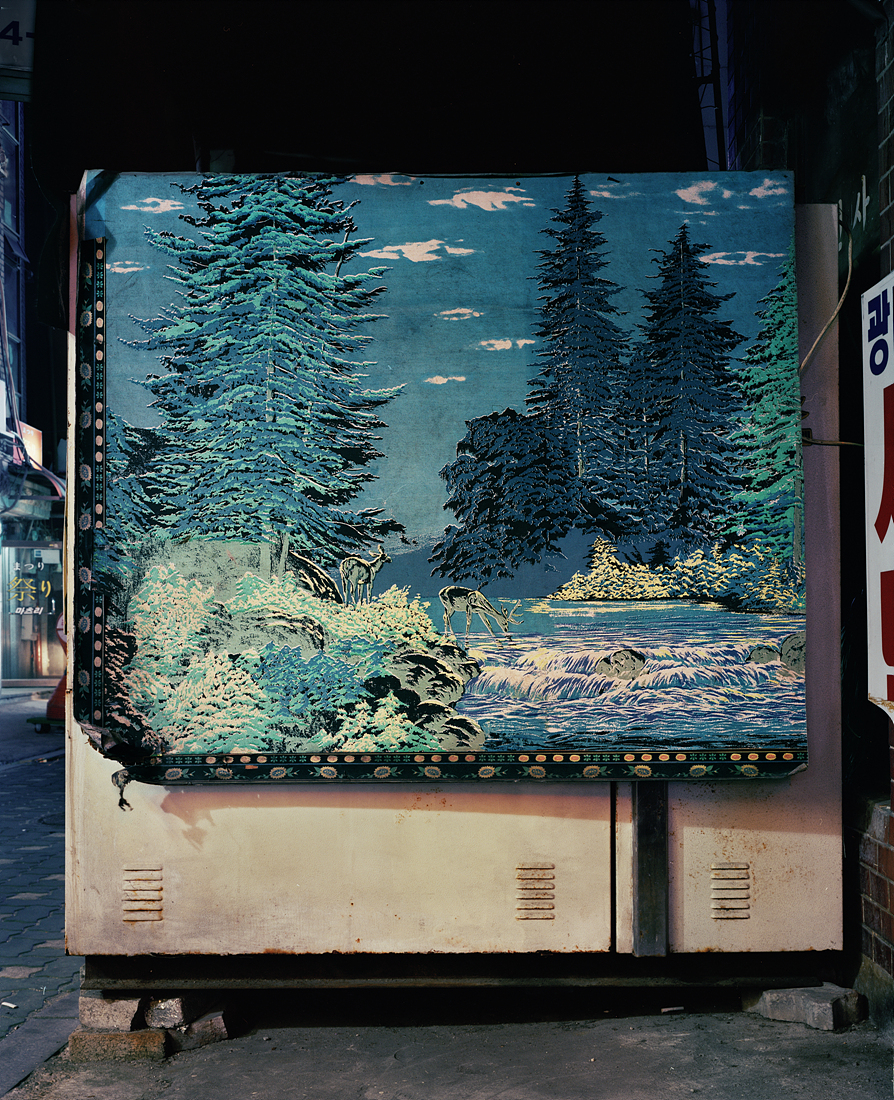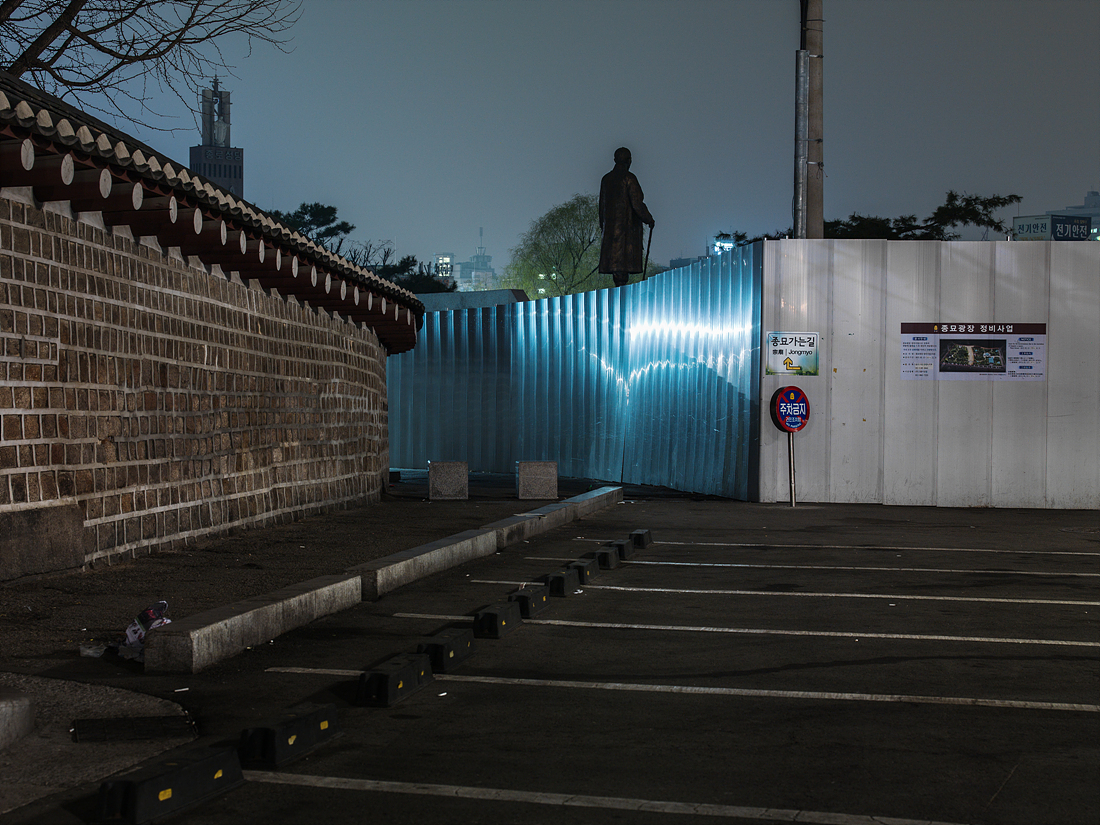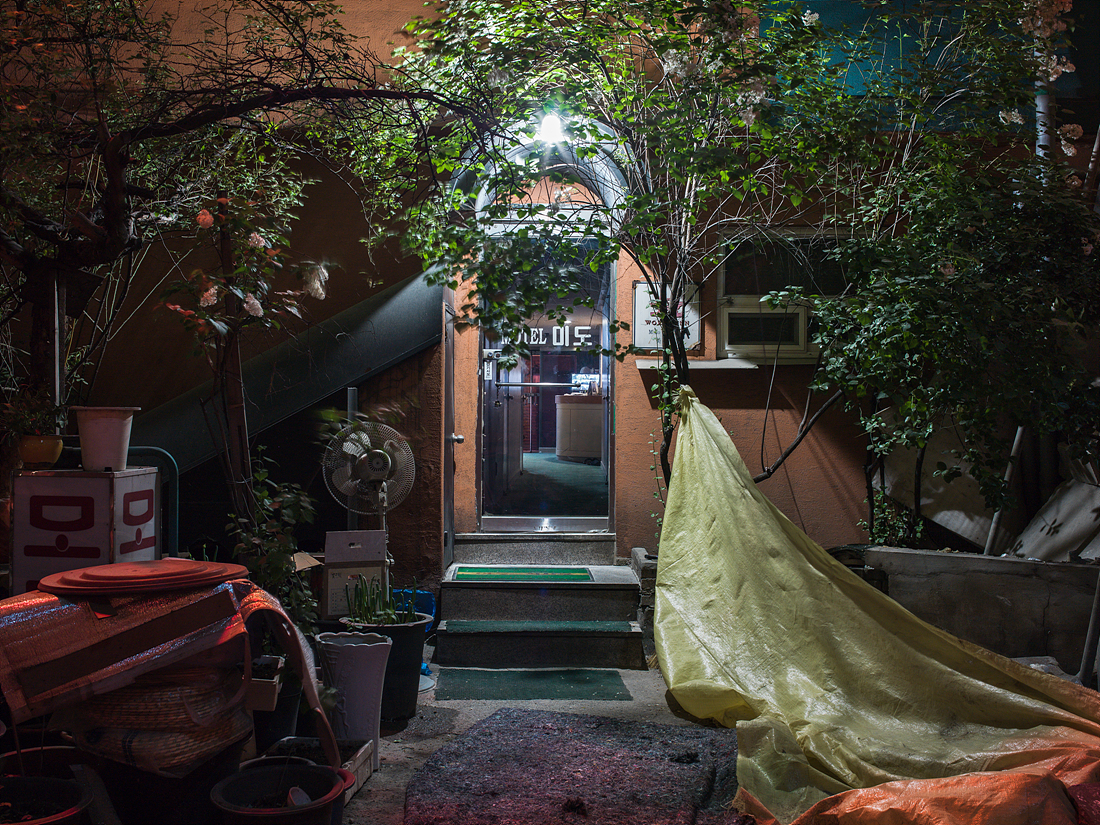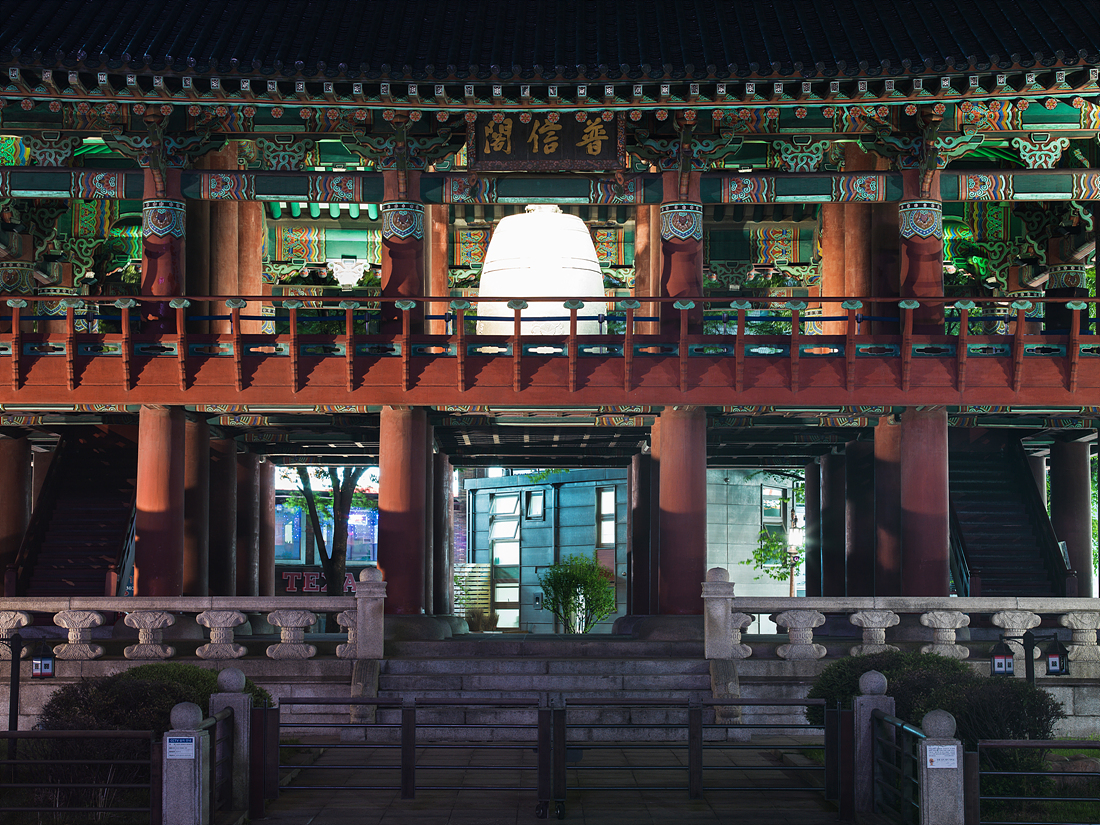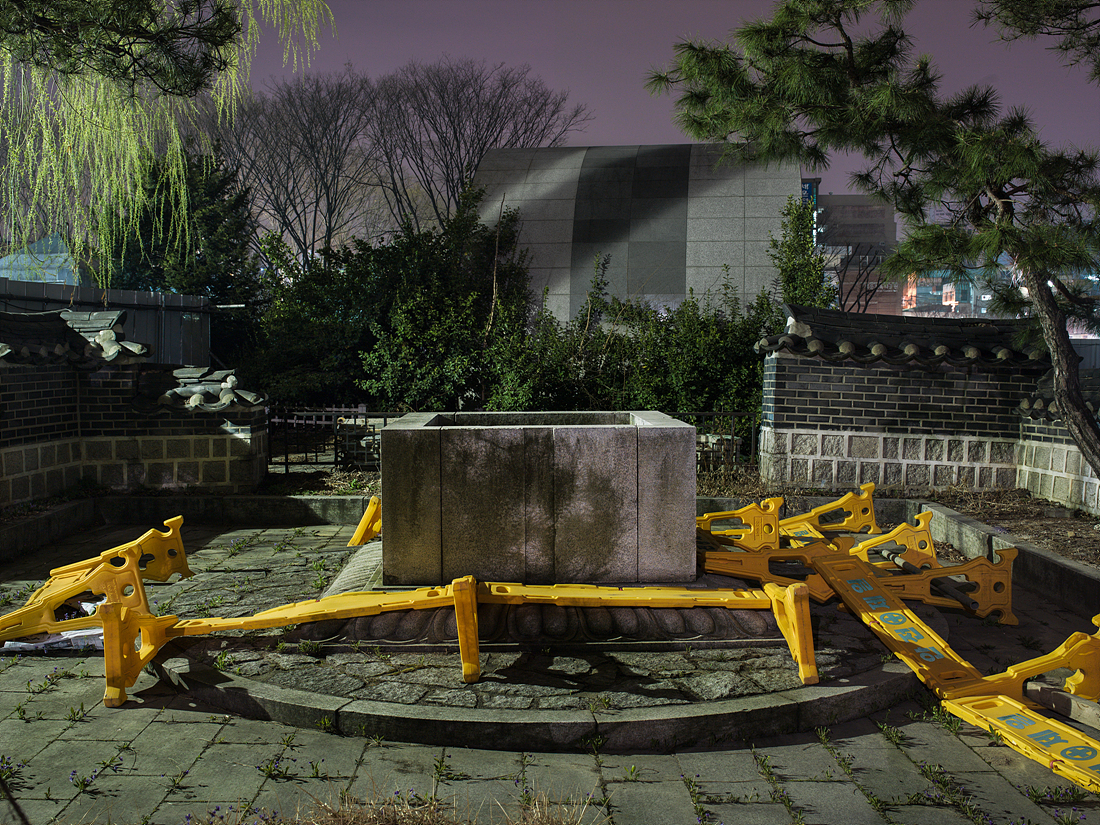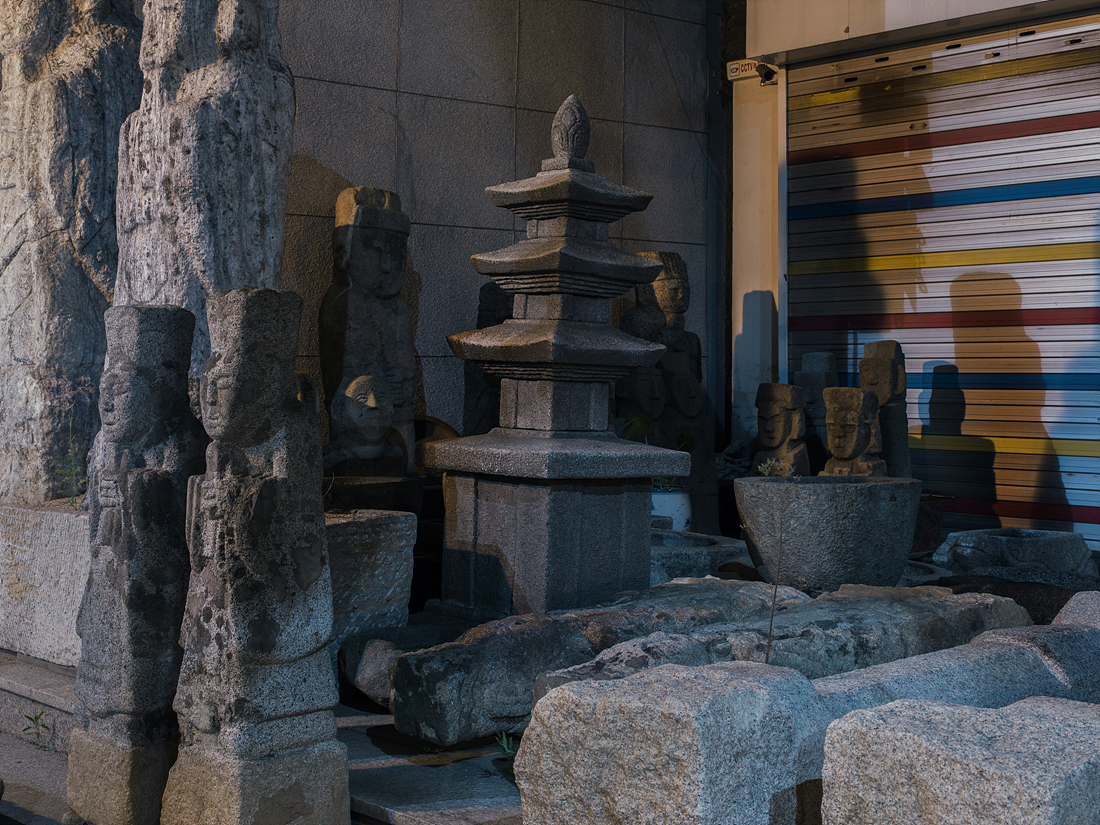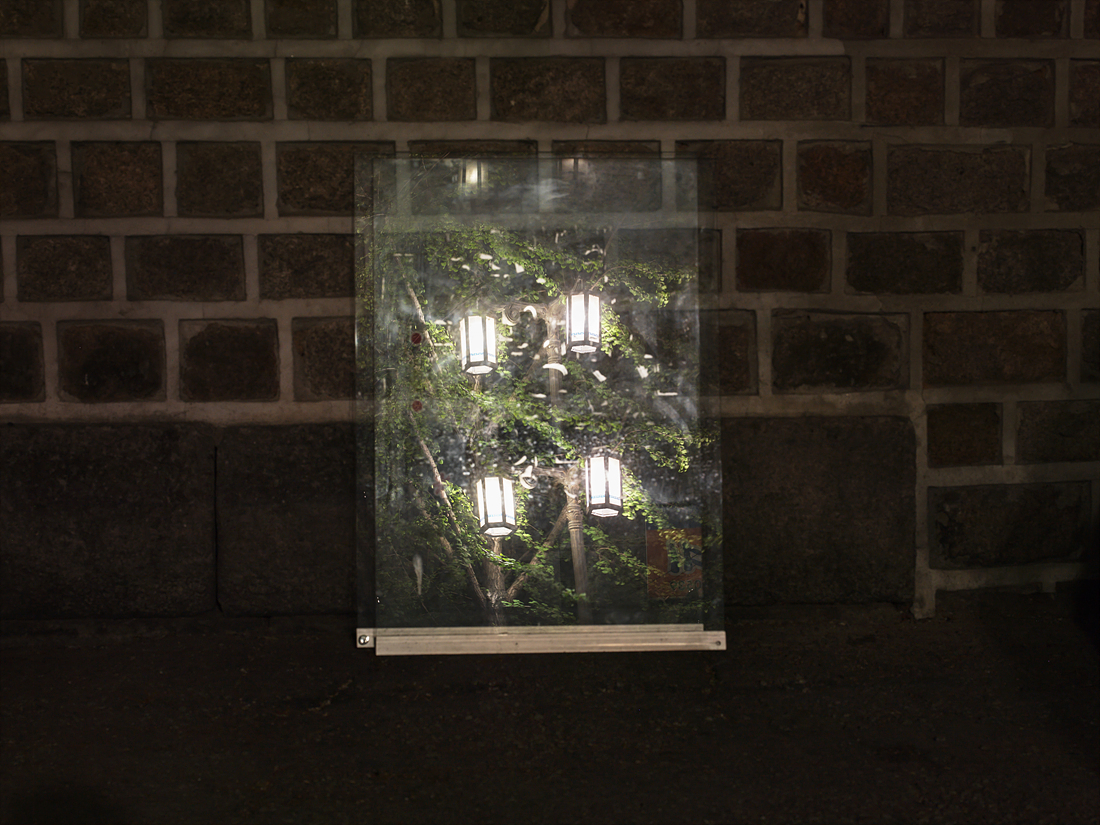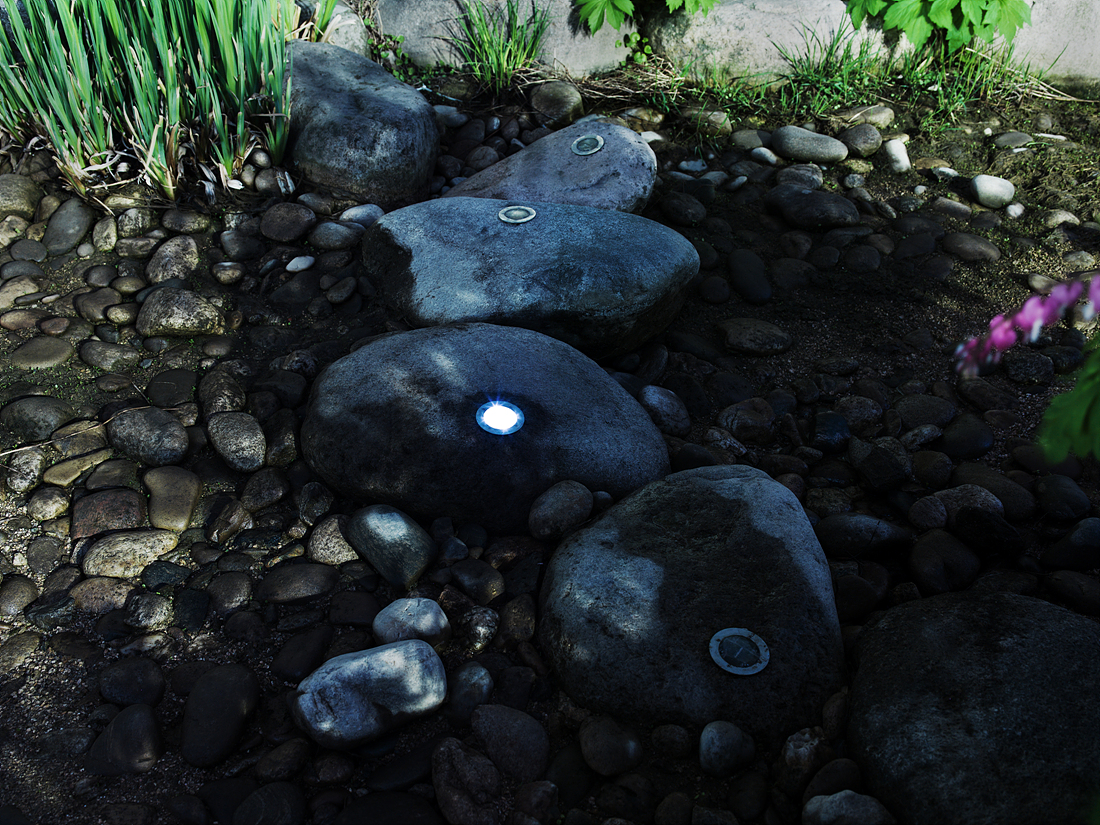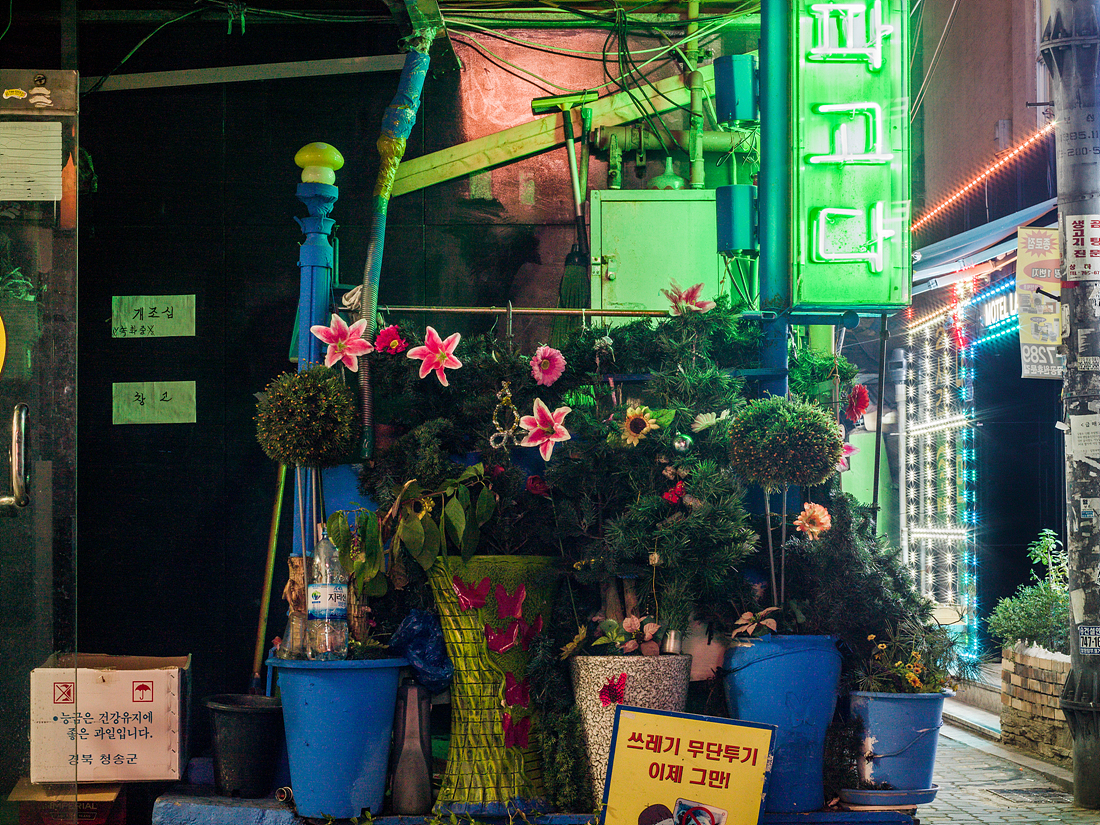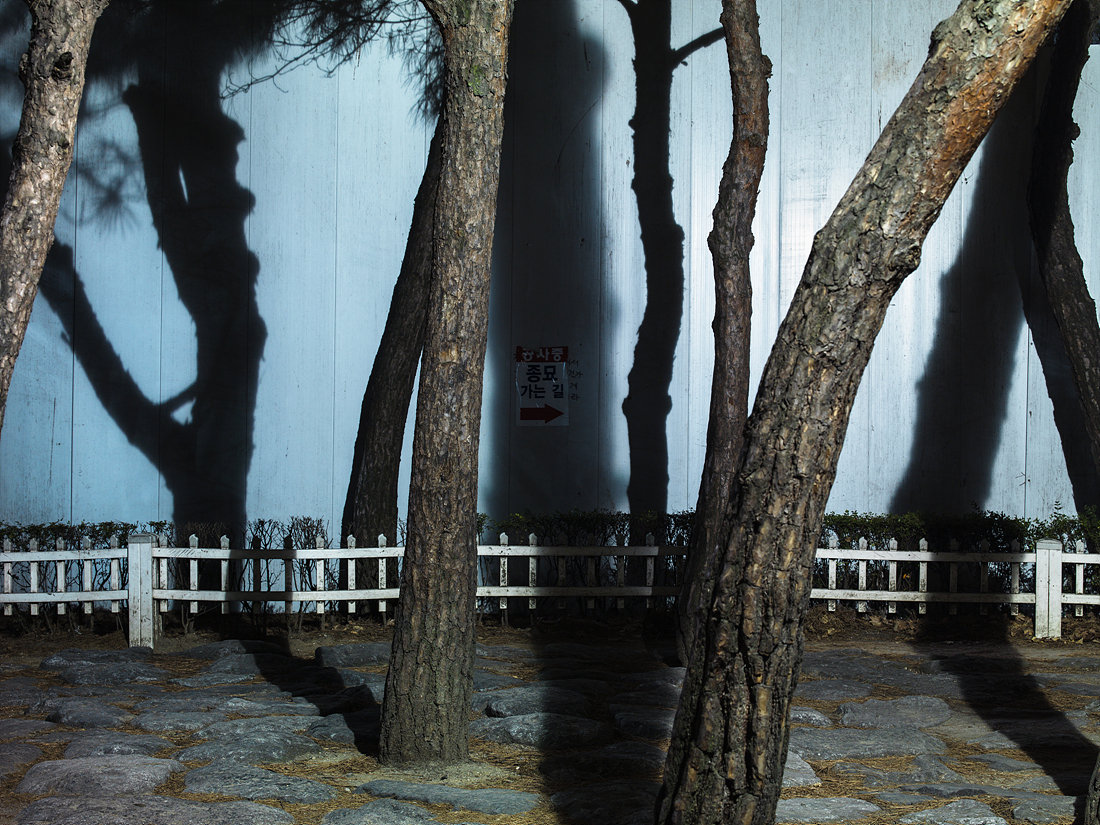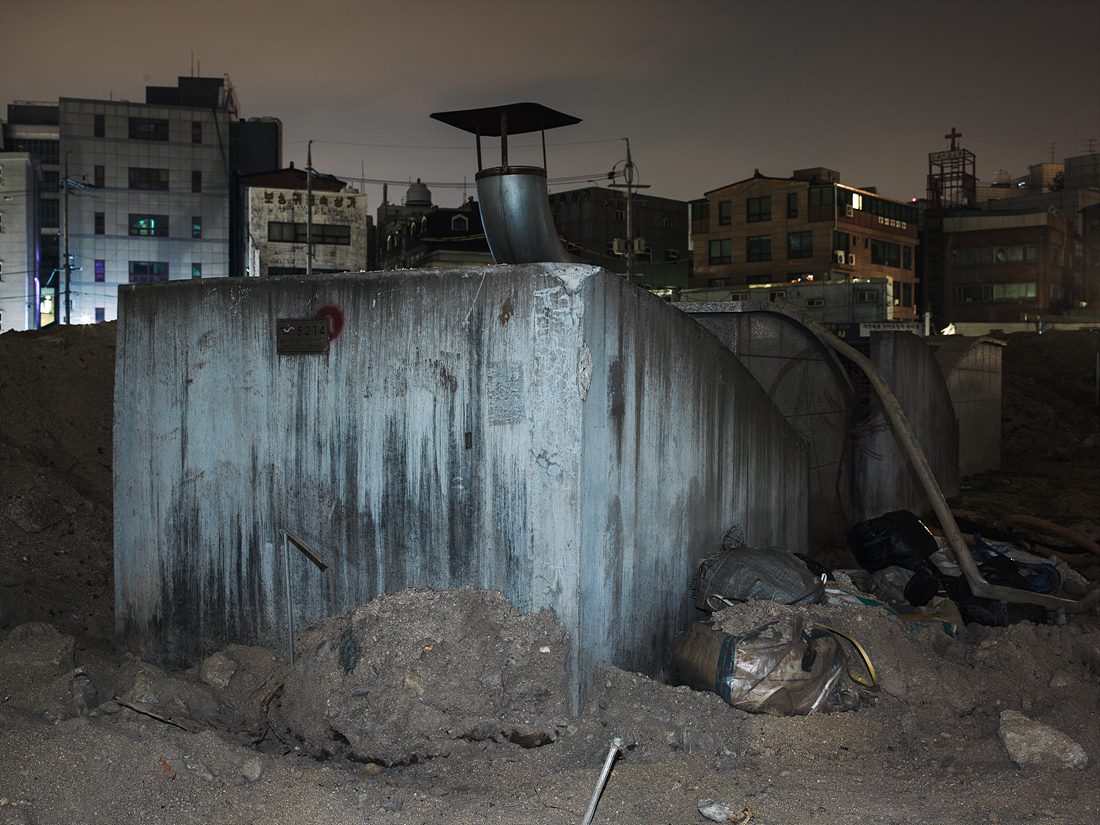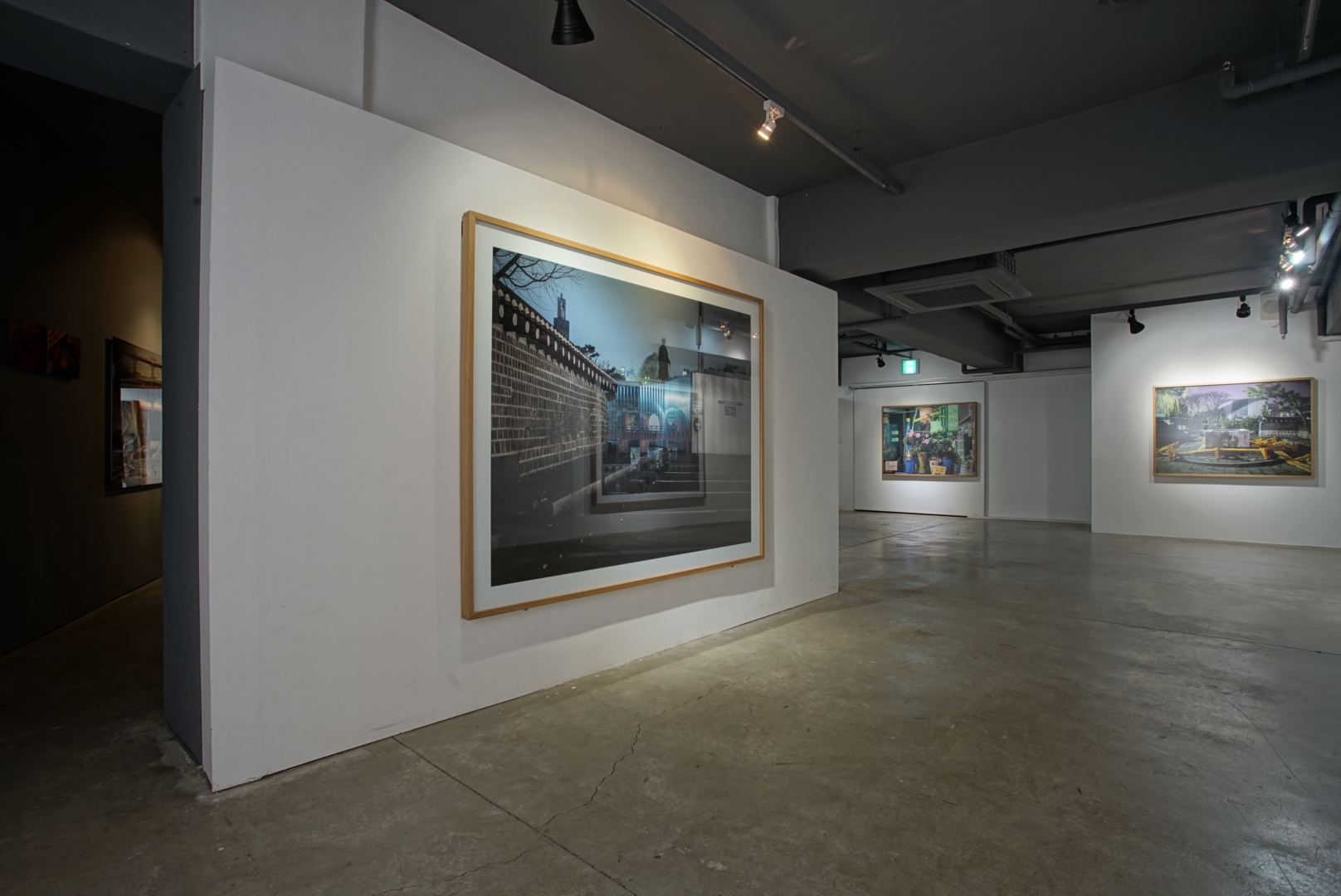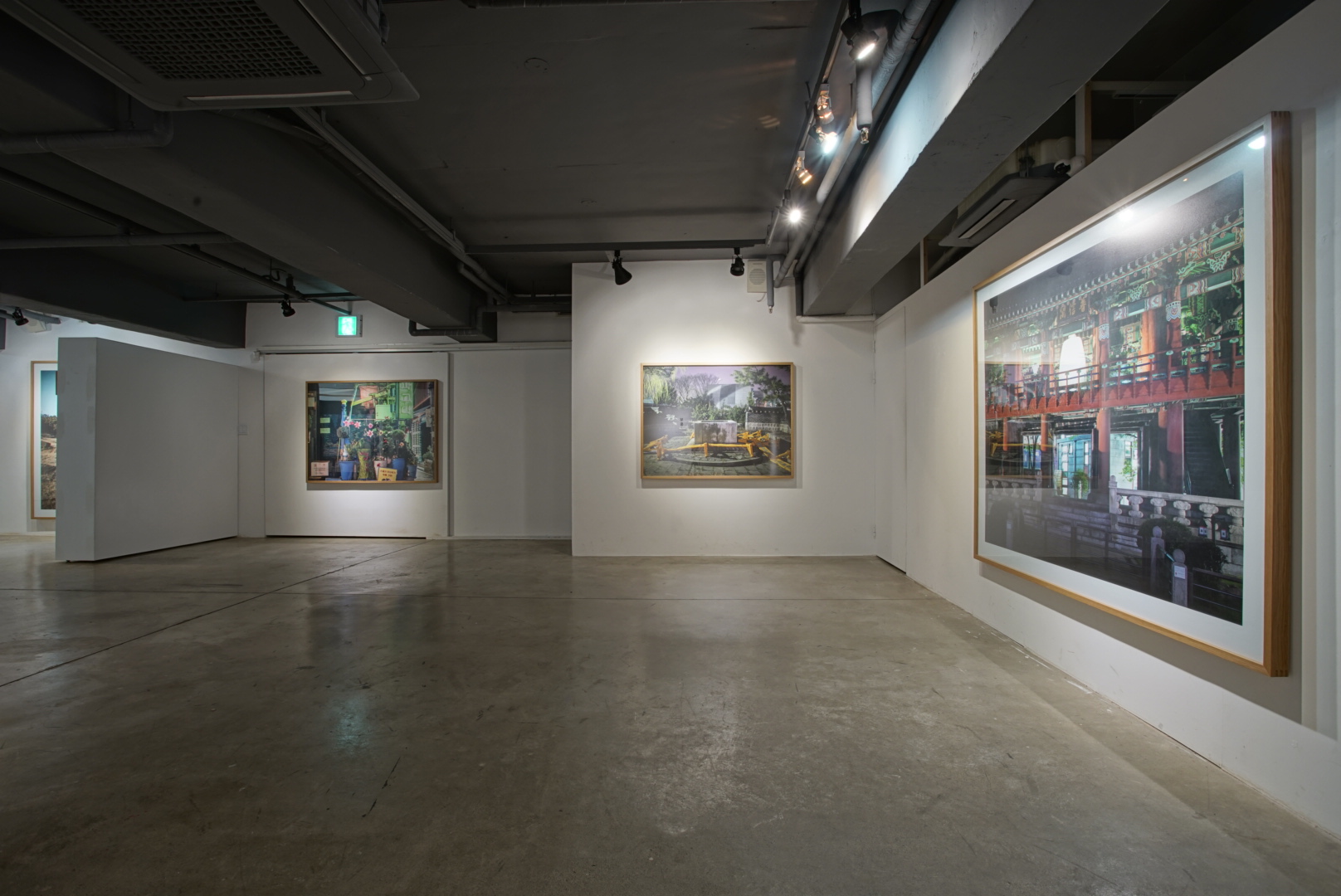Passage 2014
work note
Shortly after starting photography, I began capturing the area around Jongmyo. As I wandered and photographed Jongmyo, I started to wonder why I was so drawn to this place and why I kept returning to photograph it. What is it about Jongmyo and Jongno that compels me to continue taking pictures? What am I seeing here, and what am I seeing through photography?
In the late evening, when the streets of Jongno are sparsely populated, I was able to see traces of a special time through my lens. The familiar notions we have about life and death, the sacred and the mundane, the private and the public, continuity and discontinuity, reality and illusion, phenomena and essence, creation and destruction, infinity and zero often operate in a binary way, but in essence, they are infinitely unknowable. When I moved away from these familiar binary concepts, I could experience a passage through photography.
The ‘Passage Project’ views the connecting points between different dimensions of space as ‘passages’ and seeks out spaces and objects that function as ‘doors,’ allowing movement between these dimensions. A passage is both an exit here and an entrance there; it is simultaneously the outside and inside here, and the outside and inside there. It is another ambiguous space that connects both the inside and outside, or each side’s inside and outside, representing infinite possibilities.
Through this contemplation and observation, I realized that while photographing Jongmyo and Jongno, I was experiencing and sensing something beyond what was visible. It was a process of awe and exploration of the history and time embedded in this place, and the stories that live and breathe within it.
Jongmyo and Jongno hold a significance to me beyond being mere locations. They are passages connecting the past, present, and future, points where various dimensions intersect. Photographing these places is not just about recording their beauty but about exploring the infinite possibilities and stories contained within. Through this process, I gain new perspectives and insights, and in doing so, I come to understand myself more deeply.
통로
보이는것에서보이지않는것을찍다
사진은 현장의 기록이고, 사실을 말한다고들 한다. 하지만 사진은 종종 거짓말을 하기도 한다. 엄청난 디지털 조작이 아니더라도 앵글의 각도를 약간 변형한다던지, 사진의 특정 부분을 잘라 내는 아주 간단한 방식에 의해서 사진은 아주 그럴싸하게 없던 것도 말하고, 있던 것도 다르게 이야기하며, 종종 천연덕스러운 거짓말을 하기도 한다. 설령 사진이 이렇게 거짓말을 한다고 하 더라도, 사진이 여전히 보이는 것을 찍는다는 사실에는 변함이 없다. 하지만, 사진은 종종 작가 의눈을통해보이지않는것을찍기도한다.
안종현의 <통로> 시리즈 역시 보이는 것에서 시작했다. 조선의 왕들을 모신 종묘 인근의 신기어린 기묘한 분위기, 현란한 네온사인의 모텔, 어두운 밤 신기하게 빛을 발하는 보신각 종 그리고 마치 발굴단에 의해 발굴이라도 된 것 같은 모습으로 공사장 흙더미 안에 묻힌 공중전화 부스. 어느것하나특별하거나별날것이없는것들이었지만,종로나종묘인근골목을마주하다만나 게 되면 희한하게도 기이하고 낯설고 이상한 풍경을 만들어내는 것이 흥미로웠다고 했다. 그렇게 낯선 모습을 그대로 카메라에 담았다.
종로. 그러고 보면 종로통은 좀 특이하다. 한국 최초의 공원이자 독립선언서가 낭독되었던 탑골 공원에는 예전의 기운은 간데없고, 하릴없는 어르신들이 무료하게 시간을 보내는 곳이 되었고, 학원가와 극장가, 각종 전문 상가들이 즐비한 길 뒤편에는 야릇한 네온의 모텔들이 가득하다. 밤 이 되면 유흥가들이 기지개를 키며 낮과는 사뭇 다른 풍경들이 펼쳐진다. 지금은 사라진 피맛길 의 작은 주점들에서 피곤한 일상을 달래던 샐러리맨들에서부터, 각종 학원을 기웃거리는 젊은이 들에서, 이미 지나간 잘 나가던 한 때를 회고 하는 노인들까지. 종로1가 광화문 사거리부터 종로 3가, 종로5가 그리고 종묘인근까지 걸어가다 보면 조금씩 달라지면서 보여주는 종로통에는 다 양한 계층과 다양한 시대와 다양한 감성이 공존하고 있다.
밤. 종로의 밤은 특히 현란하다. 해가 지고 도시의 네온이 켜지면, 종로의 뒷골목은 다른 얼굴을 드러낸다. 안종현은 그 밤에 카메라를 들고 종로를 배회했다. 인공조명의 뒷배로 두고 바라보면 일상적인 것도 낯설게 다가온다.
그렇게 안종현은 우리가 보아왔던 일상적이면서도 낯선 종로를 찍었다. 언뜻 그의 사진이 종로에 대한 기록처럼 보이는 이유이다. 하지만, 그의 사진은 보이는 종로의 모습에 그치지 않는다. 다 양한 시대와 감성이 공존하는 종로에서 하나의 차원에서 다른 차원으로 낯설고 이질적인 시간과 공간, 보이는 것을 통해서 느끼게 되는 보이지 않는 것에의 기록이 있다. 작가는 그것을 일종의 ‘통로’라고 말한다. 삶에서 죽음으로, 사적인 것에서 공적인 것으로, 지속되는 것으로부터 단절로 이어가는 통로(passage). 불 밝혀진 보신각 종, 하나만 켜진 공원의 인공조명, 짙은 숲 속 저편 의 한줄기 빛은 마치 관람객을 이 세상이 아닌, 다른 어떤 공간으로 이끌어가는 장치처럼 보인다. 지금 발 딛고 서 있는 여기를 너머 보이지 않는 저기를 상상하게 만드는 동시에 지금 여기를 비 현실적인 공간으로 뒤튼다. 그래서 <통로>는 도시에 대한 기록사진이 아니다. 그것은 보이는 것 에대한것이아닌,보이는것을통해말하고자하는보이지않는것에대한기록이라할수있다.
신보슬 / 토탈미술관 큐레이터
Photographing the Unseen from the Seen
It is said speak the truth, recording moments as they happen. But at times, photo- graphs also lie and it doesn’t take an incredibly technical technique to make it happen. A shift of the angle here and a cut of a section there are all it takes for a photograph to convincingly reveal something that isn’t there, or portray what’s there in a different light. Photographs do, rather quite often and casually, lie to us. Regardless of their abil- ity “to lie”, it doesn’t change the fact that photographs still capture what is seen. But every so often, it also captures what is not seen, through the lens of an artist.
An, Jong-Hyun’s Passage series is one that starts with visible things. His photographs hold seemingly normal yet interestingly “abnormal” sights: The unexplainably mystify- ing aura that surrounds Jongmyo, the burial grounds of the kings from the Chosun dynasty flashy and flamboyantly bright neon signs; the Boshingak bell that seem to amazingly “shine” in the dark night; and a phone booth jutting out of the dirt pile of a construction site as if it’s an artifact being unearthed by archeologists. An was amazed at how the unexceptional streets of Jong-ro and neighboring areas of Jongmyo at times would appear to him as strange and foreign sceneries and captured these on film.
Jong-ro. If you think about it, Jong-ro is a rather unusual area. As Korea’s first park and the very place where the Declaration of Independence was recited, the energy of the time that used to fill Tapgol Gongwon is nowhere to be felt and now only the old, languid seniors visit the park to idle their time away. The main streets of Jong- ro have rows of learning academies, theaters and various industry stores while the backstreets are studded with motels with obscure signs. When darkness falls, the nightlife wakes up and Jong-ro transforms itself into a quite different place than it was during the day. In the evening, the alleys are filled with working men and women looking to find momentary escapes from their burdensome realities at drinking holes on the once and now vanished Pimat-gil. The younger generations trying out various learning academies, while the elders sit around and fondly reminisce their glory days of the past. Walking from the Gwanghwamoon intersection past Jong-ro 3-ga and Jong-ro 5-ga, towards the neighboring area of Jongmyo, one will notice the subtle differing classes of people, sentiments, and the remnants of time periods that make up the Jong-ro area.
Night. Jong-ro especially comes alive at night. When the sun sets and the neon signs are turned on, the backstreets of Jong-ro puts on another face. An walked these night streets of Jong-ro with his camera. Even the most normal of sights can come across as strange and exotic, when viewed with an artificial backlight.
That is how An captured the Jong-ro we know and didn’t know. Perhaps this is why it may seem like his photographs are pictorial records of Jong-ro. But it doesn’t end with what we are able see. The pictures embody in them a Jong-ro that is made up of differing times and sentiments, and are the recordings of the unseen that we are able to feel through what we see and the unfamiliar and disparate times and space that results when viewing Jong-ro from a different dimension. An calls this a “passage” of sorts, like the passage that leads life to death, switches the personal to the public and bridges the “Continuous to” the “End”. The lighted Boshingak bell, the single lit lighting that illuminates the park, and the sliver of light seen at the corner of a dark forest seem like a mechanism that leads the viewers into a space not of this world, making them leave the ground they are standing on and into an imaginary space while twisting their own reality into seeming like it is unrealistic. So actually, Passage is not a pictorial record of a city. It is not a record of the seen, but that of the unseen told through what we see.
Shin, Bo-Seul / Curator, Total Museum of Contemporary Art,
